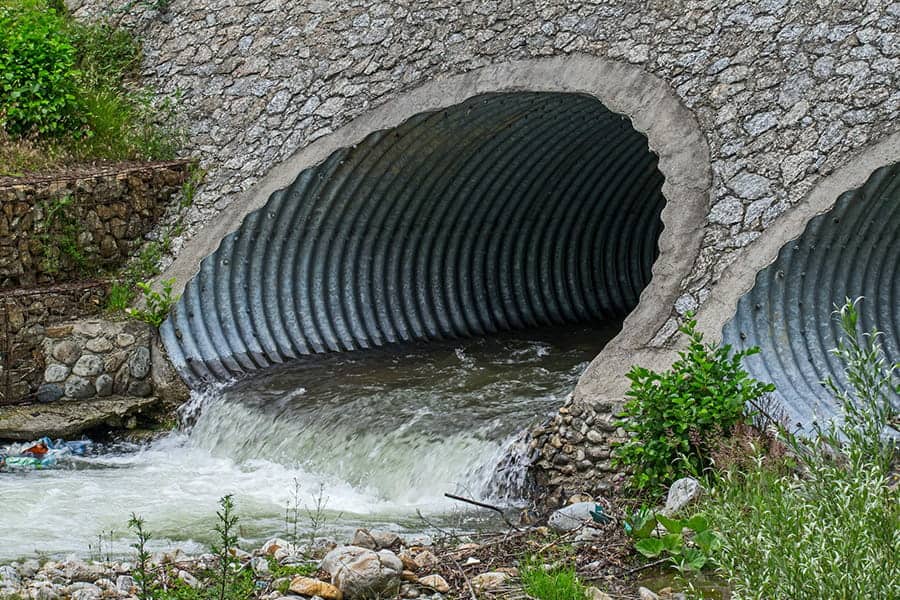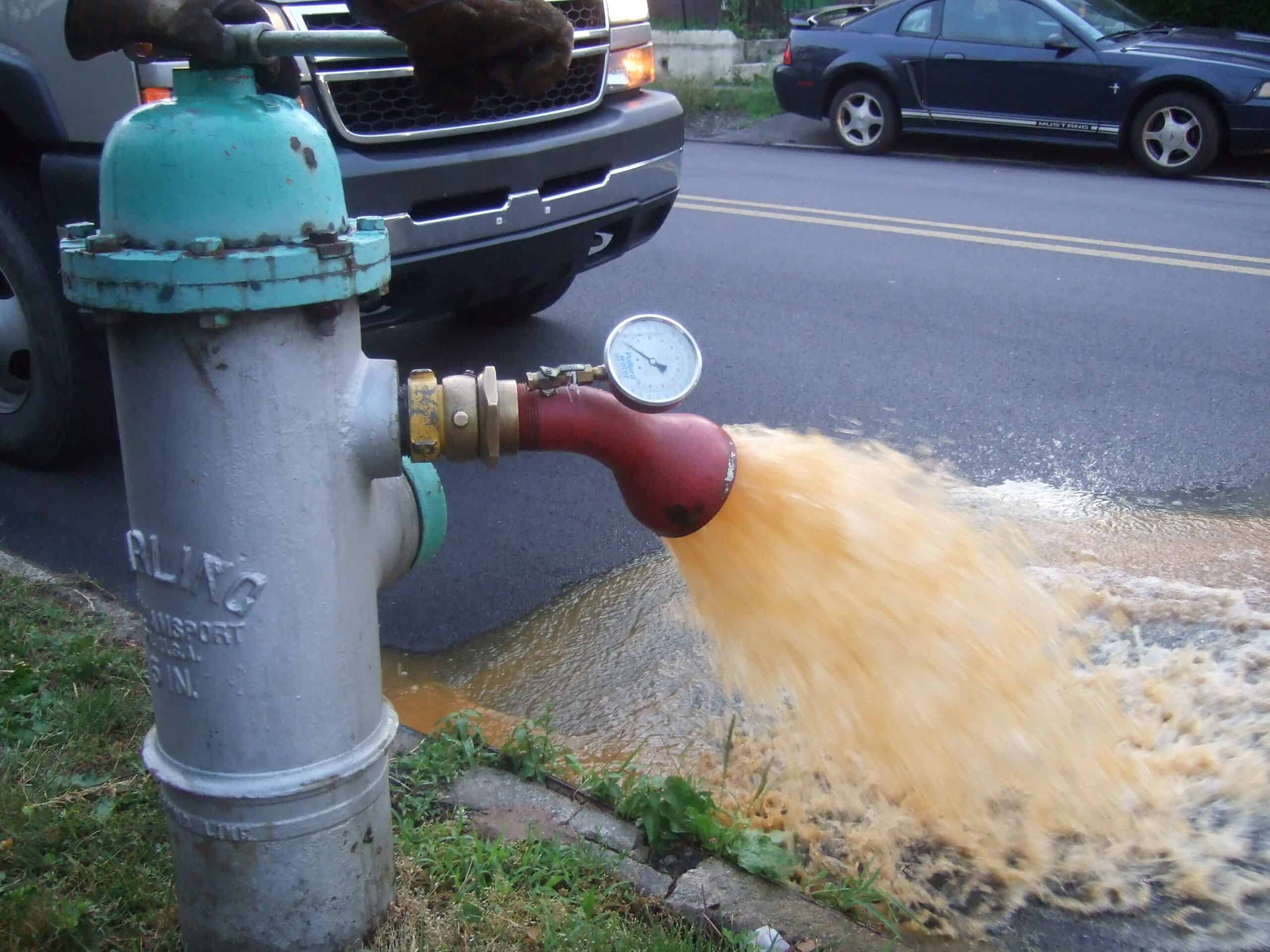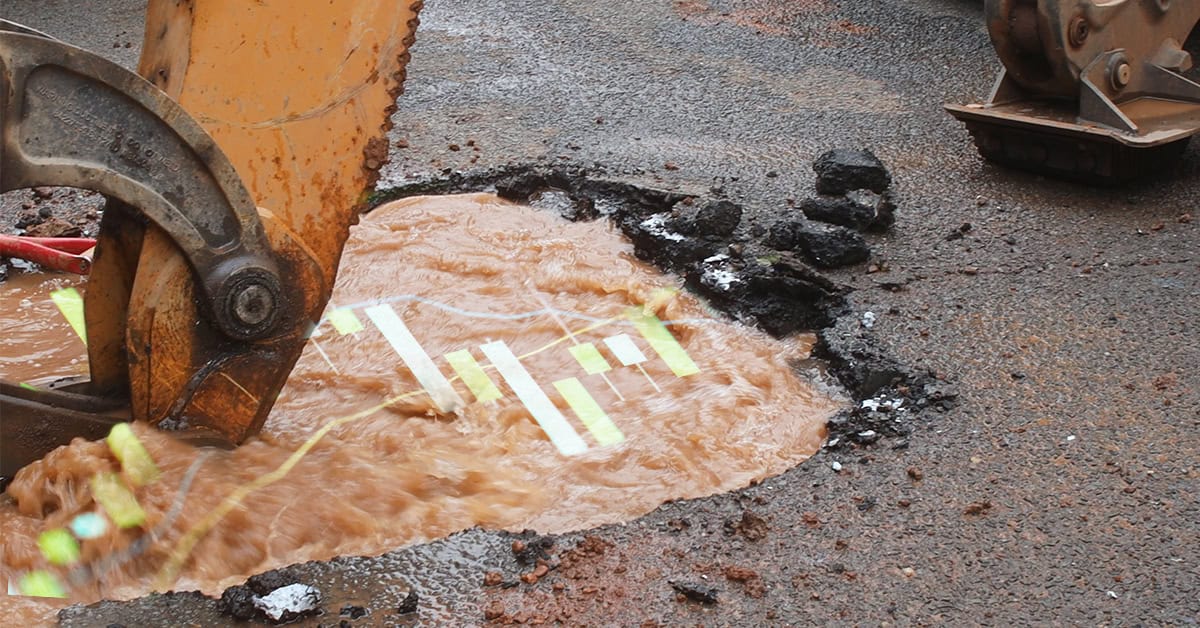The concepts of tractive force design for sewers have been around for a long time. (Actually, the term “tractive force” is incorrect as “tractive stress” does have units of force per unit area along the pipe wall in the direction of flow.)
The principal is simple. If the flow provides sufficient tractive stress, any solids in the flow will not settle out, and any that settled out will begin to move. If tractive stress is sufficient, then the sewers or channels can be considered self-cleaning.
The available tractive stress is calculated as
Where τ = tractive stress, γ= specific weight of water, S = slope, R = hydraulic radius
The deeper the water and the steeper the slope, the greater the tractive stress.
The available tractive stress is compared with the required tractive stress to move the solids. There are several different empirical equations for determining the required tractive stress. They generally depend on the size and specific gravity of the target solids to be moved. For sewers, these are usually based on 1 mm sand grains and correspond to 0.0181 lb/ft2 (0.867 N/m2) and a velocity on the order of 2 ft/s (0.6 m/s).
The joint ASCE manual of Practice 60/WEF Manual of Practice FD-6, “Gravity Sanitary Sewer Design and Construction-2nd edition” does a very nice job providing graphs and equations to help engineers determine the minimum slope to achieve self-cleaning at the user-specified “design minimum flow rate”. The term “design minimum” sounds like a contradiction.
Which actual flow should an engineer use?
Some engineers would argue that it is the peak flow on a dry day. If the sewer can reach that flow at least briefly during the day, solids should not accumulate. Determining this flow should be relatively easy for reasonable, significantly large flow rates. Problems occur, however, when one moves up into the uppermost reaches of a collection system.
There may only be a handful of customers on the most upstream sewers. In such a case, flow is not continuous but comes in pulses when a customer turns on a washing machine or shower or flushes a toilet. There are some statistical methods like the Poisson Rectangular Pulse model, which classifies every pulse by its magnitude, frequency, and duration and sums them up across customers to develop a flow pattern. But such methods are usually beyond the scope of what sewer designers want (or need) to do.
There are some places where a regulatory agency will pick some arbitrary flow to use in tractive stress calculations (e.g. 10 gpm, 40 gpm) whenever the expected design flow becomes so small it would result in unrealistically step pipes. It’s difficult to justify any value. These flow values are used to determine the minimum slope for pipes to be self-cleaning. Even if it would be possible to determine the flow for a reasonable minimum design flow, the results may require extremely steep pipes.
Calculate tractive stress with OpenFlows products
OpenFlows SewerGEMS and SewerCAD can calculate the tractive stress for all pipes for every time step. It can also indicate if the required tractive stress would be exceeded at the current time step or any time step. There is no default value, so the user must enter the required tractive stress value, which can be done globally or overridden for a specific pipe. It is also possible for the user to include a tractive stress design constraint in the automated design tool.
Let’s take an example. The standard reference for sewer design comes from the “10 State Standards” and is repeated in the ASCE/WEF manual mentioned above. In most places, the minimum sewer size is 8 in. (200 mm), and the traditional minimum slope for such a pipe is 0.004 (i.e. 4 ft/1000 ft).
The ASCE/WEF manual gives equations for the minimum required slope for a given flow and diameter. Those equations can be solved for the flow needed to achieve adequate self-cleaning. For an 8 in. (200 mm) pipe, that flow can be given as
Q = 0.00189/S1.75
Where S = slope and Q = flow, gpm.
Using the above equation, the flow would need to be 30 gpm (2 L/s) to provide sufficient tractive stress at a slope of 0.004. This leads to three cases:
1. Pipes with enough flow and slope to continuously self-clean,
2. Pipes that rarely have sufficient flow to self-clean,
3. Pipes that periodically have sufficient flow.
Unfortunately, there are a lot of upstream pipes in flat terrain that fall into the second case. These pipes tend to be maintenance problems. The possible good news is that the equation above is fairly conservative in that sanitary sewer solids don’t contain a lot of dense solids like sand. Most sanitary sewer solids tend to have specific gravity closer to one. Combined sewers can contain sand and gravel, but they also have periods of high flow during rain events.
In some situations, regulators will allow engineers to use a fairly high flow like 30 gpm (2 L/s) for those pipes with low flow, when the actual flow may be smaller. But this is essentially the same as using the 10 State Standards minimum slope of 0.004. Forcing these inflated flows into a model at the upstream end of each branch results in excessive flow calculated at the downstream reaches of the system. In my opinion, it is best to simply use the minimum slope instead of trying to trick the model into meeting a tractive stress requirement.
Calculate using OpenFlows FlowMaster
Wondering what 2 L/s (30 gpm) looks like in a 200 mm (8 in.) pipe? Here are the results in a FlowMaster calculation. Notice that the depth is 42 mm (1.6 in.), the pipe is 21% full, and the velocity is 0.42 m/s (1/4 ft/s). It’s essentially a trickle in the bottom of the pipe, and most of the time, the flow will be less (or zero).
FlowMaster also can help with a sensitivity analysis. Here is a graph showing the depth over a range of slopes and flows.
If the natural slope of the land is greater than 0.004, meeting minimum tractive stress should not be difficult to achieve. For flatter areas, this usually requires burying the upstream end of a pipe shallow and burying the downstream end deeper. This works for short runs of flat or adverse ground slope. But, if the area is large, a pump station and force main may be required to avoid very deep sewers. (i.e. The slope of the ground is either flat or adverse (uphill). For large areas like this, you may need a pump station with its associated force main, so you don’t need to dig deep.)
There is additional guidance on tractive stress design in the following Bentley Communities wiki.
https://bentleysystems.service-now.com/community?id=kb_article_view&sysparm_article=KB0016324
If you like blogs like this, you can go back to our library of blogs at https://blog.bentley.com/category/hydraulics-and-hydrology/.
Want to learn more from our resident water and wastewater expert? Join the Dr. Tom Walski Newsletter today!









